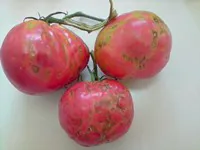 The Parietaria mottle virus (PMoV) was identified for the first time on Parietaria plants but has since been affecting other crops too, such as for example tomatoes. The virus has been detected in regions such as Piedmont, Liguria, Campania, Emilia-Romagna, Sardinia and Lazio, and can infect up to 30% of the crop.
The Parietaria mottle virus (PMoV) was identified for the first time on Parietaria plants but has since been affecting other crops too, such as for example tomatoes. The virus has been detected in regions such as Piedmont, Liguria, Campania, Emilia-Romagna, Sardinia and Lazio, and can infect up to 30% of the crop. The symptoms are similar to those caused by the tomato spotted wilt virus (TSWV), the cucumber mosaic virus (CMV) satellite RNAs (SatRNA) and the tomato mosaic virus (ToMV) and this, together with the lack of diagnostic systems in commerce (i.e. specific ELISA kits), probably led to an underestimation of the diffusion of the virus.
The Campania region is now working with CNR's Plant Protection Institute to define the biological-molecular characteristics of the PMoV samples in Campania in order to develop a specific diagnostic system.
Ten samples of pepper (Capsicum annuum) plants showing basal bright rings and mosaic on the leaves with some necrotic patches, necrotic stems and fruit with brown patches and corky rings were identified in a family garden and in a commercial greenhouse in Campania in 2012, 2013 and 2015 (Papaccella ecotype in 2012 and Eppo hybrid in 2013). The researchers of the Institute took a few samples and tested them, isolating the pathogen and sequencing the virus' genome.
Source: G. Parrella, B. Greco, E. Troiano, 'Severe Symptoms of Mosaic and Necrosis in Bell Pepper Associated With Parietaria mottle virus in Italy', Luglio 2016, Plant Disease, Vol. 100 (7), Pag. 1514.
dx.doi.org/10.1094/PDIS-02-16-0194-PDN
